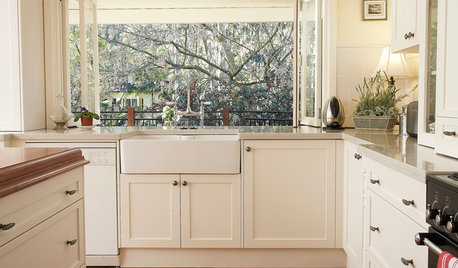Sani-Flow versus Rough-In...
sdemjsully5
11 years ago
Related Stories

HOUZZ TOURSHouzz Tour: Creating Flow for a Family Apartment
Light, Texture, Accents and Glass Partitions Create Beauty and Function
Full Story
ROOM OF THE DAYRoom of the Day: Serene Sophistication in a Master Bathroom
Rich textures, careful planning and symmetry give an Atlanta couple a beautiful new place for unwinding
Full Story
BATHROOM DESIGNA Crash Course in Bathroom Faucet Finishes
Learn the pros and cons of 9 popular faucet finishes
Full Story
MOST POPULARKitchen Evolution: Work Zones Replace the Triangle
Want maximum efficiency in your kitchen? Consider forgoing the old-fashioned triangle in favor of task-specific zones
Full Story
CONTRACTOR TIPSContractor Tips: How to Shop for Your Remodel
Small mistakes in buying remodeling materials can add up to huge cost overruns. Here's how to get things right the first time
Full Story
MOST POPULAR12 Key Decorating Tips to Make Any Room Better
Get a great result even without an experienced touch by following these basic design guidelines
Full Story
HOUZZ TOURSHouzz Tour: Saving a Historic Gem in Washington
A Seattle-area developer skips the usual scrape-and-subdivide, restoring a Usonian-style house designed by a Wright protégé
Full Story
KITCHEN SINKSEverything You Need to Know About Farmhouse Sinks
They’re charming, homey, durable, elegant, functional and nostalgic. Those are just a few of the reasons they’re so popular
Full Story
STAIRWAYSThe Upstairs-Downstairs Connection: Picking the Right Stair Treatment
Carpeting, runner or bare wood? Check out these ideas for matching your staircase floor treatment to upstairs and downstairs flooring
Full Story
REMODELING GUIDESDesigner Confessions: Torn Between Wood Floors
19 Photos to Help You Choose a Wood Floor Finish
Full StoryMore Discussions







lazypup
sdemjsully5Original Author
Related Professionals
Milford Plumbers · Fish Hawk Handyman · Hillcrest Heights Handyman · 20781 Kitchen & Bathroom Remodelers · Auburn Kitchen & Bathroom Remodelers · Bellevue Kitchen & Bathroom Remodelers · Champlin Kitchen & Bathroom Remodelers · North Arlington Kitchen & Bathroom Remodelers · Paducah Kitchen & Bathroom Remodelers · Pueblo Kitchen & Bathroom Remodelers · Rochester Kitchen & Bathroom Remodelers · Roselle Kitchen & Bathroom Remodelers · Tuckahoe Kitchen & Bathroom Remodelers · Wilmington Island Kitchen & Bathroom Remodelers · Paradise Kitchen & Bath Fixturesbrickeyee
piedmontnc
lazypup
piedmontnc
lazypup
piedmontnc